Ditapis dengan
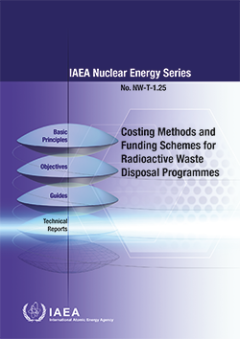
Costing Methods and Funding Schemes for Radioactive Waste Disposal Programmes
Reliable methods for estimating the cost of a radioactive waste disposal programme are crucial to ensure that the necessary funding for completing the disposal programme is available. Estimating the cost for disposal is however a challenging and complex task. Disposal programmes themselves are complex and long-term undertakings and conditions can be expected to change significantly over the tim…
- Edisi
- -
- ISBN/ISSN
- 978-92-0-108819-2
- Deskripsi Fisik
- 90 Hal
- Judul Seri
- -
- No. Panggil
- 621.48335 IAE C

Handling and Processing of Radioactive Waste from Nuclear Applications | Tech…
This report provides detailed information on the handling, processing and storage techniques most widely used and recommended for waste from non-fuel-cycle activities, i.e. radioactive waste generated during the application of nuclear techniques and radioisotopes in industry, medicine, research and education. The report was designed to meet mainly the needs of developing countries by focusing o…
- Edisi
- 402
- ISBN/ISSN
- 92-0-100801-5
- Deskripsi Fisik
- 153 p; 725KB
- Judul Seri
- -
- No. Panggil
- 621.4838 IAE H
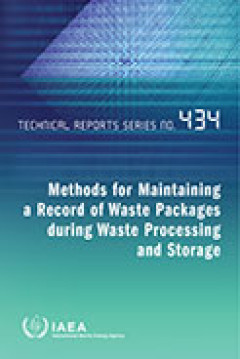
Methods for Maintaining a Record of Waste Packages during Waste Processing an…
During processing, radioactive waste is converted into waste packages and sent for storage and ultimately for disposal. A principal condition for acceptance of a waste package for storage or disposal is its full compliance with waste acceptance criteria for disposal or storage. To declare compliance of a waste package with waste acceptance criteria, a system for generating and maintaining recor…
- Edisi
- -
- ISBN/ISSN
- 92-0-114704-X
- Deskripsi Fisik
- 37 pages, 332KB
- Judul Seri
- -
- No. Panggil
- 621.4838 IAE M
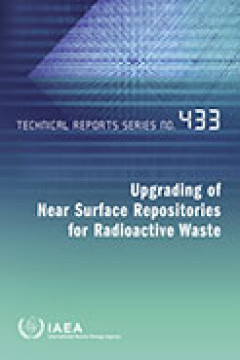
Upgrading of Near Surface Repositories for Radioactive Waste | Technical Repo…
This report considers a variety of circumstances that may require corrective actions to be assessed or implemented at near surface disposal facilities. The circumstances leading to the corrective actions, or the corrective actions themselves, may be of either a technical or a non-technical nature. Methodologies that can be employed to implement effective solutions to problems are discussed, inc…
- Edisi
- 433
- ISBN/ISSN
- 92-0-112704-9
- Deskripsi Fisik
- 137 p. : Illus. 24 cm
- Judul Seri
- Technical Reports Series No. 433
- No. Panggil
- 621.4838 IAE U
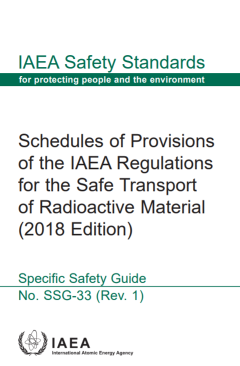
IAEA - Safety Standards Series No. GSR Part 5 : PREDISPOSAL MANAGEMENT OF RAD…
This Safety Requirements publication applies to the predisposal management of radioactive waste of all types and covers all the steps in its management from its generation up to its disposal, including its processing (pretreatment, treatment and conditioning), storage and transport. Such waste may arise from the commissioning, operation and decommissioning of nuclear facilities; the use of radi…
- Edisi
- -
- ISBN/ISSN
- 978–92–0–111508–9 / 1020–525X
- Deskripsi Fisik
- 56 p
- Judul Seri
- -
- No. Panggil
- -
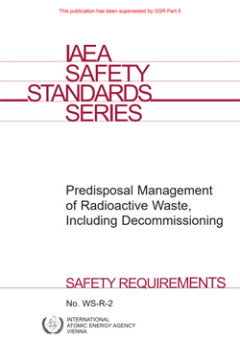
IAEA Safety Standards Series.Safety Requirements No.WS-R-2.Predisposal Manage…
This publication establishes safety requirements relating to the predisposal management of radioactive waste arising from: the operation and decommissioning of nuclear facilities; the application of radionuclides in industry, medicine and research; the processing of raw materials containing naturally occurring radionuclides; and the cleanup of contaminated sites. Safety requirements for the rel…
- Edisi
- -
- ISBN/ISSN
- 92-0-100300-5
- Deskripsi Fisik
- 26 Halaman
- Judul Seri
- -
- No. Panggil
- -

Release of Sites from Regulatory Control on Termination of Practices, Safety …
An increasing number of nuclear facilities are coming to the end of their useful lives and are being, or are going to be, decommissioned with a view to removing the sites from regulatory control. In many cases, decommissioning activities include the decontamination of land, buildings and other structures such as underground pipes and tanks, or ponds, at the site that became contaminated as a re…
- Edisi
- -
- ISBN/ISSN
- 9201016069 / 1020525X
- Deskripsi Fisik
- 37 p. : Illus. ; 24 cm
- Judul Seri
- Safety Standards No. WS-G-5.1
- No. Panggil
- -
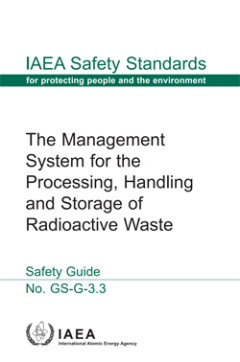
THE MANAGEMENT SYSTEM FOR THE PROCESSING, HANDLING AND STORAGE OF RADIOACTIVE…
The objective of this Safety Guide is to provide guidance on the development and implementation of management systems for the pretreatment, treatment, conditioning and storage of radioactive waste. This publication also includes a description of how to apply the requirements detailed in IAEA Safety Standards Series No. GS-R-3, to the activities associated with producing a packaged waste form fo…
- Edisi
- -
- ISBN/ISSN
- 9789201020086 / 1020525X
- Deskripsi Fisik
- 79 p. : Illus. ; 24 cm
- Judul Seri
- Safety Standards Series No. GS-G-3.3
- No. Panggil
- -
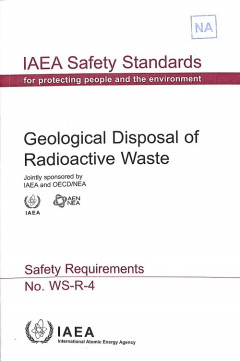
Geological Disposal of Radioactive Waste, Safety Requirements
The objective of this Safety Requirements publication is to set down the protection objectives and criteria for geological disposal and to establish the requirements that must be met to ensure the safety of this disposal option, consistent with the established principles of safety for radioactive waste management.
- Edisi
- -
- ISBN/ISSN
- 920105705
- Deskripsi Fisik
- 49 p. : Illus. ; 24 cm
- Judul Seri
- Safety Standards Series No. WS-R-4
- No. Panggil
- -
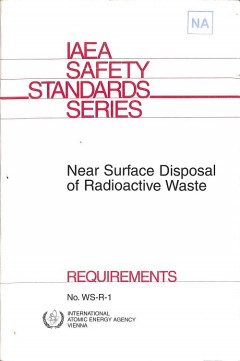
Near Surface Disposal of Radioactive Waste, Requirements
This publication sets out the basic safety requirements related to the disposal of radioactive wastes in near surface repositories. As a Safety Requirements publication it is supported by a number of associated Safety Guides which provide guidance on the implementation of the requirements. Its principles are derived from the Safety Fundamentals publication, Safety Series No. 111-F, The Principl…
- Edisi
- -
- ISBN/ISSN
- 9201010990 / 1020525X
- Deskripsi Fisik
- 29 p. : Illus. 24 cm
- Judul Seri
- Safety Standards Series No. WS-R-1
- No. Panggil
- 621.0397 IAE n
 Karya Umum
Karya Umum  Filsafat
Filsafat  Agama
Agama  Ilmu-ilmu Sosial
Ilmu-ilmu Sosial  Bahasa
Bahasa  Ilmu-ilmu Murni
Ilmu-ilmu Murni  Ilmu-ilmu Terapan
Ilmu-ilmu Terapan  Kesenian, Hiburan, dan Olahraga
Kesenian, Hiburan, dan Olahraga  Kesusastraan
Kesusastraan  Geografi dan Sejarah
Geografi dan Sejarah